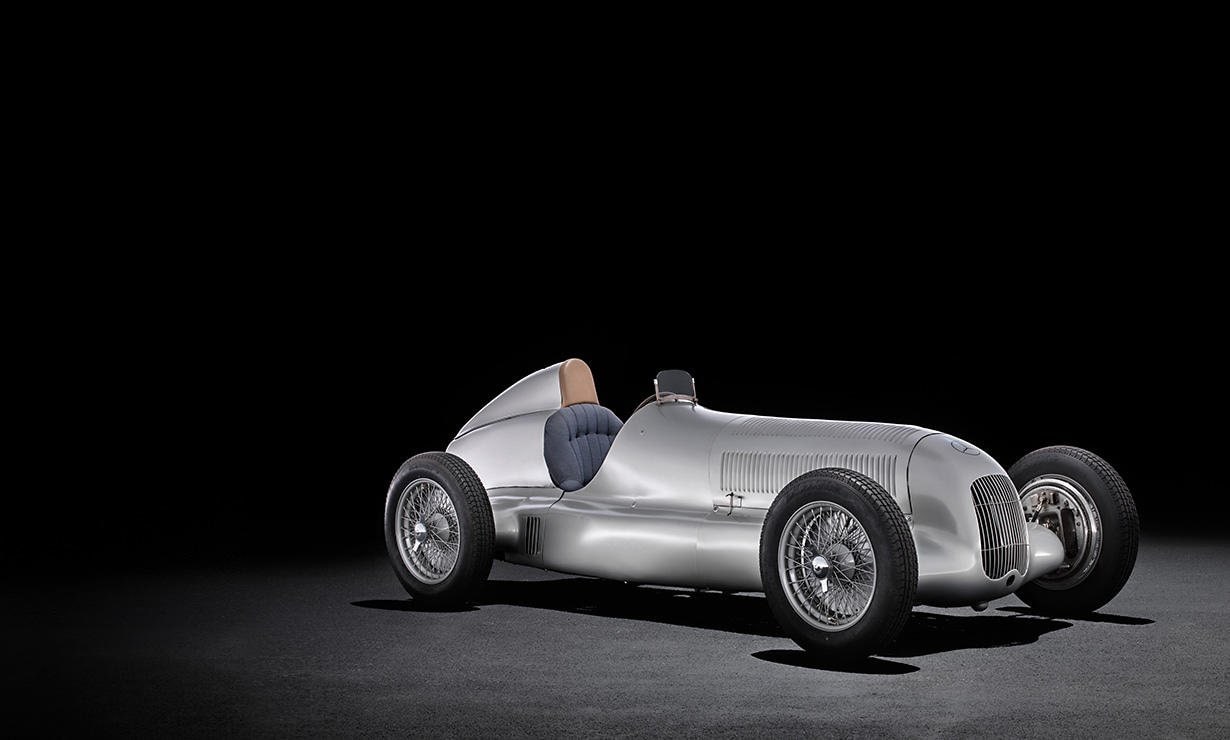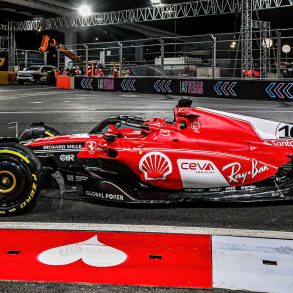The Die Silberpfeile Cars
We waited again. Then they came.
Far away in the distance we heard an angry, deep-throated roaring – as someone once remarked, like hungry lions impatient for the arena. A few moments later, Manfred von Brauchitsch, red helmeted, brought a great, silver projectile snaking down the hill, and close behind, his teammate Rudolf Caracciola, then at the height of his great career. The two cars took the hairpin, von Brauchitsch almost sideways, and rocketed away out of sight with long plumes of rubber smoke trailing from their huge rear tyres, in a deafening crash of sound.
The startled Pressmen gazed at each other, awe-struck.
“Strewth,” gasped one of them, “so that’s what they’re like!”
Auto Union Type C
The economic expansion of the 1920’s came to a sudden halt with the Wall Street Crash of 1929. For Ferdinand Porsche, Technical Director at Steyer this meant being laid off after less then one year with the Austrian company. Porsche had by this time built a large reputation as an automotive engineer to go along with his equally large ego. Unemployment should have been a temporary setback but Porsche insisted that any job offer need to be accompanied with a seat on the Board of Directors. Unable to find a company willing to meet his demands he decided to set up his own company. Learn more…
Auto Union Type D
started the new season under a cloud. Professor Ferdinand Porsche’s contract was not renewed after the 1937 season in a strange case of economics and was snapped up by Mercedes who fed his company several lucrative contracts. Just after the beginning of the year they lost their greatest driver when Bernd Rosemeyer was killed during a speed attempt. While Robert Eberan von Eberhorst assumed most of Porsche’s duties there could be no replacement of the beloved Rosemeyer. Only the talents Nuvolari could lessen the loss to the team’s success if not to their heart. With all of the turmoil including the threat by some board members to shut down the racing team, Auto Union was still able to create a new car in 18 months. Learn more…
Mercedes Benz W25
The new Auto Union, designated the P-Wagen, was ready in late fall, 1933, several months before the Mercedes.In January they invited the press to view their new car and the press in their enthusiasm declared the sleek new car as the German race car. Daimler-Benz who had yet to debut their car was not amused by this new upstart. 1934 would bring in the 750 kilogram formula that was meant to make racing cheaper in the cash strapped Thirties. The minimum race length was set at 500 kilometers. Learn more…
Mercedes Benz W125
1936 belonged to Auto Union and especially their brilliant young driver Bernd Rosemeyer. The Mercedes W25 was showing its age and Mercedes decided to temporarily withdraw from competition to reorganize their racing department. Rudolf Uhlenhaut was appointed Technical Director of the Rennabteilung, or racing department that would work between the Design Office and the Team Manager, Alfred Neubauer. Uhlenhaut was 30 years old at the time and decided that the only way for him to fully understand the problems with the Grand Prix Cars was to drive them himself. Soon he was lapping the Nurburgring at times just below the drivers. Grand Prix racing was different in those day as the cars were tested and re-tested constantly prior to the race meeting. Learn more…
Mercedes Benz W154
The Mercedes M154 was built in response to the new formula for 1938 which specified a maximum capacity of 3,0000 cc for super-charged engines and 4,500 cc for normally aspired cars with a sliding minimum weight scale. The engine for the new car was a 60° V-12 with 48 valves, twin Roots superchargers and no less than nine oil pumps!. The engine used a special fuel mixture which contained methyl alcohol, nitrobenzene, acetone, and sulfuric either. The car consumed about a liter of fuel for every kilometer (2.8 mpg) traveled. The W154 carried more than 400 liters (88 gal) of fuel in two tanks, one in the tail and the other between the driver’s seat and the engine. Some of the fuel was actually used to cool the pistons. Learn more…
Mercedes Benz W163
There is some question as to whether the W163 can even be called a separate model from the W154 since the 163 actually refers to the new M163 engine which was also used on the W154 for the 1938 season. That engine was fueled by a witch’s brew of 86% methyl alcohol, with nitro-benzine, acetone and sulphuric ether mixed in giving the engine a whopping 2 mpg. Their rival literally had to “eat their fumes”. 105 gallons were carried in two tanks, one in the tail and the other under the driver’s seat. As the fuel emptied the driver would use a lever to compensate for the changing weight distribution. What was also apparent to everyone in the 1939 car was its new bodywork. The Duralumin shell presented a low, wide shark-like nose tapering to a more compact tail forming a tight skin over the engine. Total weight was 150 lbs. less than last years car while the new two-stage supercharged M163 engine would produce approximately 480 bhp. Learn more…
Mercedes Benz W165
Alfred Neubauer, the Mercedes team manager, was told in 1938 that next years Tripoli Grand Prix would be limited to 1.5 liter cars the better to insure an Italian victory. The minimum time required for producing a racing car at that time was approximately 18 months. They would only have 8 months before the Tripoli Grand Prix and the situation looked hopeless. Back at Stuttgart a meeting was held and all around the table there was a sense of gloom. The Italians were about to kick the Germans out of the riches race of the year. Max Sailor, the managing director and an old racing driver felt that they could not back down in the face of this challenge and determined that Mercedes would build a car even if it required his factory to work day and night. Learn more…










